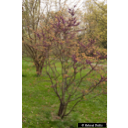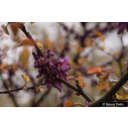Useful information about the taxon (species, subspecies, variety...)
Cercis siliquastrum L. 1753
Fabaceae (Leguminosae, Papilionaceae)
(APG IV)Judas tree
Taxon concept: The Plant List (2014), version 1.1
Distribution: Europe: France, Apennine Peninsula, Balkan Peninsula; Turkey, Syria, Israel, Jordan; introduced to Crimea and Iberian Peninsula
Cercis siliquastrum L. - Accepted: Cercis siliquastrum L. bei Zander 2008; Familie: Fabaceae (Leguminosae, Papilionaceae) (Zander 2008)Cercis siliquastrum L. - Accepted: Cercis siliquastrum L. bei The Plant List (2010); Familie: Fabaceae (Leguminosae, Papilionaceae) (APG III)Cercis siliquastrum L. - Accepted: Cercis siliquastrum L. bei The Plant List (2014), version 1.1; Familie: Fabaceae (Leguminosae, Papilionaceae) (APG III)Cercis siliquastrum L. - Accepted: Cercis siliquastrum L. bei World Flora Online; Familie: Fabaceae (Leguminosae, Papilionaceae) (APG IV)Cercis siliquastrum L. - Accepted: Cercis siliquastrum L. bei World Flora Online - APG IV (Angiosperms); Familie: Fabaceae (Leguminosae) (World Flora Online - APG IV (Angiosperms))
- Color of flower
- bright pink
- Flowers
- cauliflor
- Flower ecology
- insect-pollinated (entomophilous)
- Life form
- shrub or small tree
- Leaves
- heart-shaped, entire
- Foliage persistence
- deciduous
- Fruits
- purplish pods (legumes)
- Fruit ecology
- wind-dispersed (anemochorous)
- Soil conditions
- preferentially on calcareous soils
- Light conditions
- full sun plant, partial shade plant
- Natural occurrence (habitat)
- stony dry slopes, maquis, along the banks of rivers and streams
- Vegetation typ and synecology (plant community)
- temperate to warm-temperate (Mediterranean) deciduous to evergreen forests and scrubland
- Usage
- as ornamental tree
- Phytopathogenic organisms
- may be infested by the fungus-derived Verticillium wilt
- Altidudinal lower limit (sea level in m)
- 0
- Altitudinal higher limit (sea level in m)
- 1,000
Erhardt, W., Götz, E., Bödeker, N. & Seybold, S. (2008): Der große Zander. Enzyklopädie der Pflanzennamen. Band 2. Arten und Sorten. Eugen Ulmer KG, Stuttgart (Hohenheim), 18. Aufl., 2103 S.; Pritsch, Günter et al. (2007): 200 Trachtpflanzen erkennen und bewerten.. Kosmos, Stuttgart; Schick, B. & Spürgin, A. (1997): Die Bienenweide. Eugen Ulmer Verlag, Stuttgart, Auflage: 4., völlig neubearb. u. erw. A., 216 S. 978-3800174188.; The International Plant Names Index (2009). Published on the Internet http://www.ipni.org; Courtesy to IPNI, 2009. Exported from IPNI at date: 2009-09-22 20:17:51; The IUCN Red List of Threatened Species. www.iucnredlist.org;
Diese Webseite verwendet Google Maps, um Karten und Standorte von Pflanzen in den Hohenheimer Gärten anzuzeigen. Dadurch werden unter Umständen Daten an Google weitergeleitet, was mit einer Verarbeitung Ihrer personenbezogenen Daten verbunden sein kann. Die Datenschutzerklärung von Google finden Sie hier: Datenschutzerklärung von Google
| Sex | Standort | Accession number | Planting year | Donation | IPEN | Lat. | Long. |
|---|---|---|---|---|---|---|---|
| Parzelle A | EG-A-067-13823 | 2003 | + | XX-0-HOH-EG-A-067-13823 | 48,7105899185 | 9,2051553546 | |
| Parzelle D | EG-D-022-16226 | 1960 | XX-0-HOH-EG-D-022-16226 | 48,7098925116 | 9,207182981 | ||
| Parzelle S | LG-S-063-19704 | 2000 | XX-0-HOH-LG-S-063-19704 | 48,706778396 | 9,2118220012 |






































